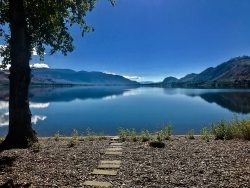by Ford Waterstrat and Lee Chapman. Lake Osoyoos Association
Lake Osoyoos in Okanogan County is an international lake of 5,750 acres that spans the U.S.-Canada border. The northern two-thirds of the lake is in Canada and the southern third is in Okanogan County, Washington.
Water flows into the lake from Canada’s Okanogan Watershed, starting in Penticton, BC, so essentially a river runs through Lake Osoyoos. Unfortunately, this allows uncaptured milfoil fragments to flow through the lake into the Okanogan River and thus to the Columbia. The problem has been exacerbated by mechanical milfoil harvesting that has been practiced in Canada since the mid-1980’s.
The harvesting has allowed fragments to establish and spread milfoil to the U.S. side of Lake Osoyoos and the Okanogan and Columbia Rivers. When Canada harvests milfoil, Osoyoos lakeshore owners see mounds of milfoil wash up on their waterfront.
In 2013, the Lake Osoyoos Association (LOA) based in Oroville, WA, began to write grants with the Washington Department of Ecology. They got two grants that allowed them to develop a comprehensive management plan, along with the Okanogan County Noxious Weed Board, and provided funds for three years of milfoil applications from 2014-2016. As part of the plan, they also looked at other milfoil control methods, particularly milfoil weevils, and using scuba divers.
When grant funding expired after 2016, the LOA knew they had to find a more sustainable funding source to fight milfoil and address other water quality issues.
After learning more about Lake Management Districts at WALPA’s 2016 conference, LOA members began contacting LMD’s in Eastern Washington. The group invited Skip Wells from Deer Lake to talk with them and to look at their format, which was extremely helpful in getting their LMD started.
The LOA began learning all they could about RCW 36.61, which allows for the creation of LMD’s, and sharing what they learned with the Okanogan County Planning Office and the County Commissioners.
Subsequently they canvassed lakeshore owners on both sides of the lake, informing them about what a lake management district could do for the lake. In discussing the formation of an LMD, the LOA members were careful to use the term “special assessment” rather than “tax,” thinking that owners would find that language more acceptable.
They also decided to be specific and conservative in approaching the special assessment by stating that the goal was to have the special assessment at around $150 per lake parcel and not to deal with secondary owners.
Many issues arose during this process, including the fact that agriculture is economically significant in Oroville, and many orchards border the lake. After several meetings with agricultural interests, the LOA decided to exclude agricultural lots from the LMD with the caveat that lots subsequently developed would then be subject to the special assessment.
After many public meetings over a year and a half with Okanogan County Commissioners who helped them make a better LMD, the LMD was finally approved on October 8, 2018. Funds will be collected beginning in April and again in October 2019. This will finally provide them a sustainable revenue source over the next five years to begin a more comprehensive plan to deal with milfoil and other water quality issues in the lake.










